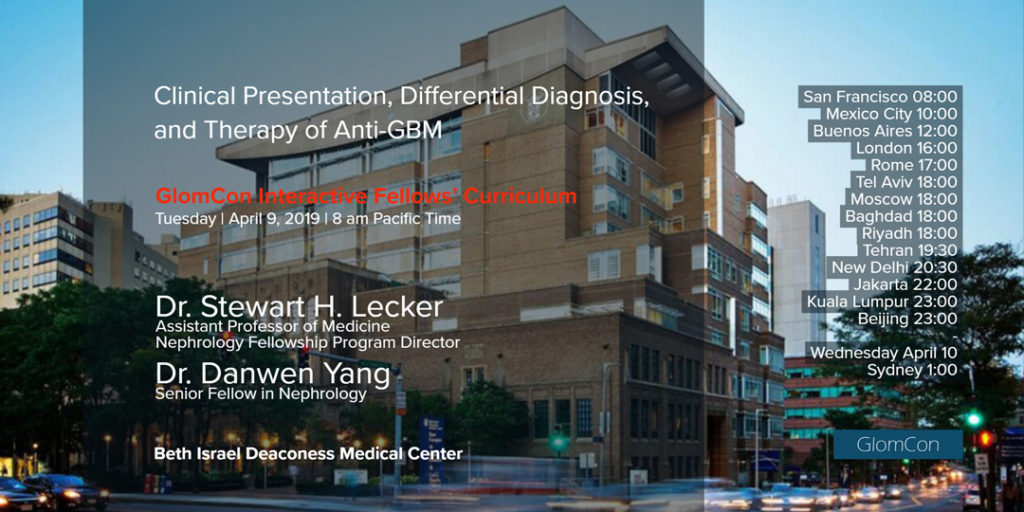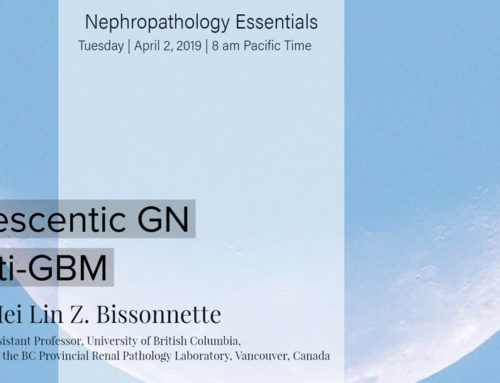CASE-BASED DISCUSSION
Clinical presentation, differential diagnosis and therapy of Anti-GBM disease
In this GlomCon Conference, Dr. Stewart H. Lecker presented three distinct cases of anti-GBM disease and reviewed the relevant literature regarding disease epidemiology and treatment. Our Moderator’s Notes are derived from his live presentation.


By Dr. Swati Arora
Key points:
- Typical Anti-GBM presentation with RPGN
Epidemiology:
- Anti-GBM disease is rare, less than 1.6 per million per year
Bimodal distribution:
- 1st peak in young adults, male predominant, 2nd peak in older adults (>60 year), equal incidence in male and females, pulmonary symptoms less common
Clinical presentation:
- 80-90% with kidney involvement, typically RPGN
- 40-60% with alveolar hemorrhage
- Minority with isolated alveolar hemorrhage
Diagnosis:
- Identification of anti GBM antibodies in serum or linear Ig staining in the tissue
- Crescentic GN by kidney biopsy, +/- evidence of alveolar hemorrhage
Treatment:
- Plasma exchange: daily 4L exchange with 5% albumin replacement fluid (or fresh frozen plasma if recent kidney biopsy or alveolar hemorrhage) for 14 days or until antibodies disappear. Serial estimates of anti-GBM disappearance was more rapid with PLEX + Immunosuppression (IS) as compared to IS alone (1).
- Oral cyclophosphamide 2-3mg/kg for 2-3 months (dose reduction if age>60 yrs).
- Oral prednisone 1mg/kg/day, tapered over 6-9 months.
- According to KDIGO 2012 guidelines, patients who are on dialysis at presentation and have 100% crescents in an adequate biopsy sample, and do not have pulmonary hemorrhage should be spared immunosuppressive therapy given the unlikely event of recovery, and the spontaneous resolution of circulating anti-GBM antibodies.
Prognosis:
- A recent study reported a better chance of renal recovery with >25% versus <25% normal glomeruli.
- Very low chance of renal recovery (9%) if the patient was dialysis dependent at presentation. No patients who were both dialysis dependent and had 100% cellular crescents recovered kidney function in this and other studies (see references below)
- Pulmonary-limited anti-GBM disease:
- Pulmonary predominant disease rare (unclear incidence, likely <10%) but may precede renal disease by weeks or years.
- Triggers for pulmonary disease: smoking, infection, inhaled toxins (cocaine, hydrocarbons).
- Treat with prednisone, cyclophosphamide and plasma exchange, as for RPGN, with expected >90% response rate.
- SWISS cohort: Patients with higher creatinine level were more likely to receive PLEX. Patients with normal renal function or mild proteinuria had longer time interval to diagnosis, received less steroids, and had a lower need for dialysis (3).
- Atypical Anti-GBM disease (renal-limited):
During the conference discussion erupted on whether this category of disease presentation is rightfully referred to as “atypical anti-GBM”, or whether a better term should be selected. While some cases are indeed an atypical clinical and pathological presentation of anti-GBM mediated renal disease, many others are due to numerous different patho-mechanisms, which may neither be related to antibody formation against GBM, nor all of the same cause.
Cases of linear staining against IgG along the glomerular basement membrane, but without detectable anti-GBM antibodies in the serum have been termed “atypical anti-GBM disease” (4). While in some cases evidence exists as to why this may be the case, for many yet unidentified causes several theories have been proposed:
- The ELISA for typical anti-GBM antibody (against alpha-3(IV) collagen) has a sensitivity of 95-100% and specificity of 91-100%. If negative, check Western blot (more sensitive). Some case of “atypical anti-GBM may be attributed to lack of sensitivity of serum assays.
- The serum anti-GBM assay can be negative if there is a non-classical epitope, quaternary epitope structure. In these circumstances western-blot against human GBM extract should be able to identify any unforeseen antibody activity.
- Low circulating levels, (as above, an issue of sensitivity)
- Passive adsorption. Here, the term “anti-GBM” or “atypical anti-GBM” would be misguiding, as it implies anti-body activity and autoimmunity, when such thing is not in play. This bears important implication for treatment, as one may be tempted to treat an unknown disease like the actual anti-GBM.
- Monoclonal gammopathy associated “atypical anti-GBM”. The linear IgG deposits in atypical anti-GBM disease can be polytypic (kappa and lambda both positive) or monotypic (kappa or lambda positive): Patients with polytypic IgG have more proteinuria and a worse prognosis as compared to those with monotypic IgG
- Similarly, here, the monoclonal deposition may indeed be that of passive adsorption of light/heavy chains without auto-reactivity. While some may consider the treatment of these category of presentations as MGRS, the term “atypical anti-GBM” can be confusing to practicing clinician.
- Antibodies that do not fix complement (IgG4) might also result in less severe renal disease.
Renal outcomes are generally better in atypical than in classic anti-GBM disease (4).
It is unclear how best and for how long to treat these patients, in the absence of a serum biomarker to monitor disease activity. MMF and Rituximab have been used.
It is also unclear whether this disease should be considered a separate disease entity to classic anti-GBM disease, at least until the epitope against which antibodies develop or other key characteristics are known.
References:

